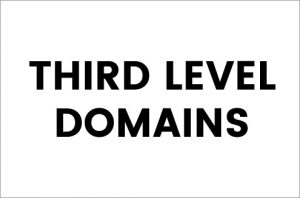Third Level Domains


Date: 01/01/2002
In large organizations, every department or division may include a unique third-level domain that can act as a simple, yet effective, way of identifying that particular department.
Various third-level domain names are used to balance the load on sites with heavy traffic. At times, names like www1 or www2 are used for this objective.
For example, in www.mydomain.com, “www” is the third-level domain. The default or the most commonly used third-level domain is “www”. The third-level domain is generally used to mention a certain server inside a company.
Domain names are made with a minimum of two levels, a top-level domain (TLD) and a second-level domain. TLD is the extension or suffix attached to the domain names. Only a small selection of predefined TLDs are available, including .com, .org, .net, .biz, etc.
A second-level domain refers to the part of a Uniform Resource Locator (URL) that specifies the precise administrative owner linked to an Internet Protocol (IP) address. The second-level domain name incorporates the TLD name as well. For example, in www.mydomain.com, “.com” is the TLD and “mydomain.com” is the second level domain.
Third-level domain names are not mandatory unless the user has a specific requirement. It is actually possible to own a fully functional domain name like “mydomain.com”. All that is needed is two levels: the top level domain and the second-level domain name. However, the usage of third-level domain names can really add clarity to domain names, which makes them more intuitive.
Customized third-level domains are also used for specific purposes. For instance, if mydomain.com has a file transfer protocol (FTP) server to let users download files, its third-level domain name can be termed ftp and the full domain name would then be ftp.mydomain.com. Similarly, the domain names such as support.mydomain.com and members.mydomain.com can be employed to differentiate the support department and member department of mydomain.com respectively. This will help direct the Web traffic accordingly.
Third-level domains, which are written immediately to the left of a second-level domain. There can be fourth- and fifth-level domains, and so on, with virtually no limitation. An example of an operational domain name with four levels of domain labels is sos.state.oh.us. Each label is separated by a full stop (dot). ‘sos’ is said to be a sub-domain of ‘state.oh.us’, and ‘state’ a sub-domain of ‘oh.us’, etc. In general, subdomains are domains subordinate to their parent domain. An example of very deep levels of subdomain ordering are the IPv6 reverse resolution DNS zones, e.g., 1.0.0.0.0.0.0.0.0.0.0.0.0.0.0.0.0.0.0.0.0.0.0.0.0.0.0.0.0.0.0.0.ip6.arpa, which is the reverse DNS resolution domain name for the IP address of a loopback interface, or the localhost name.